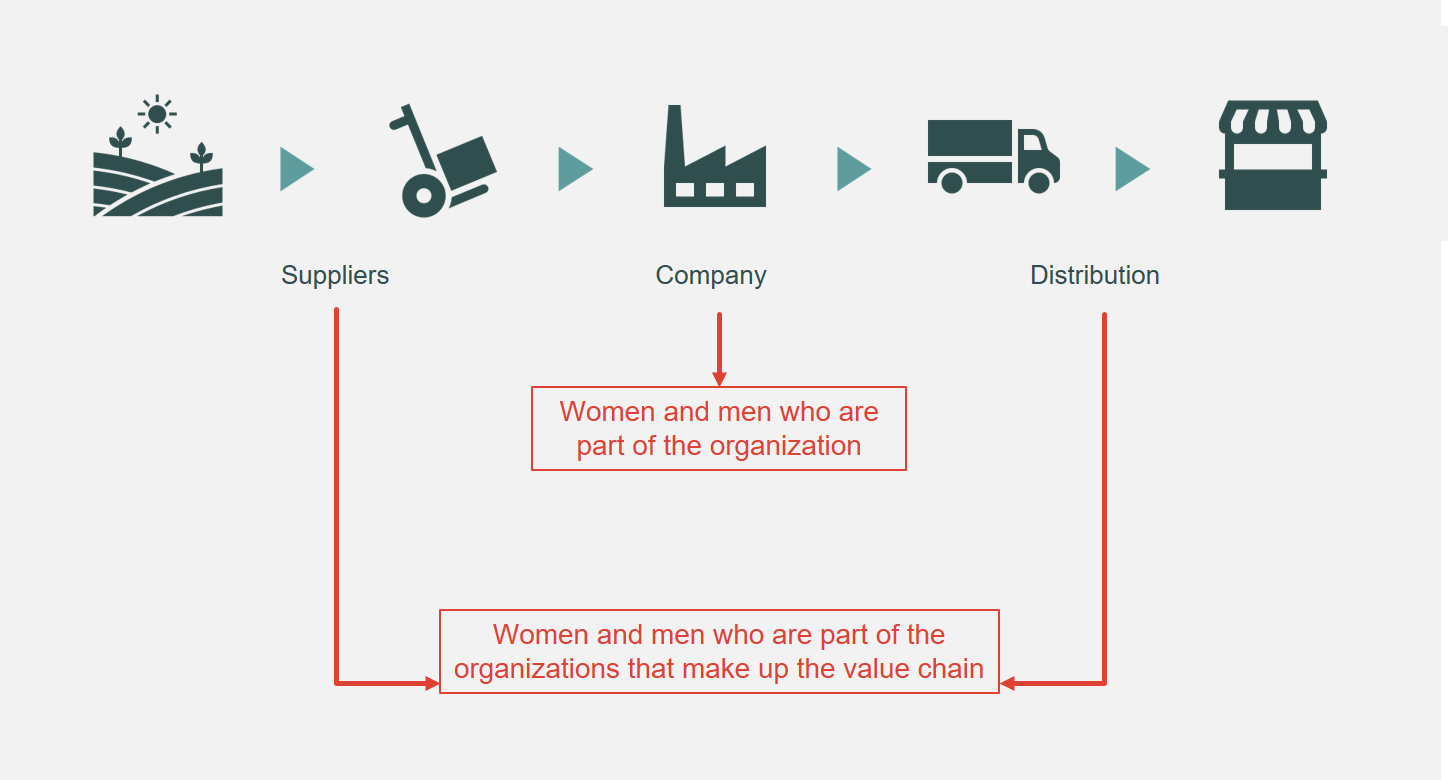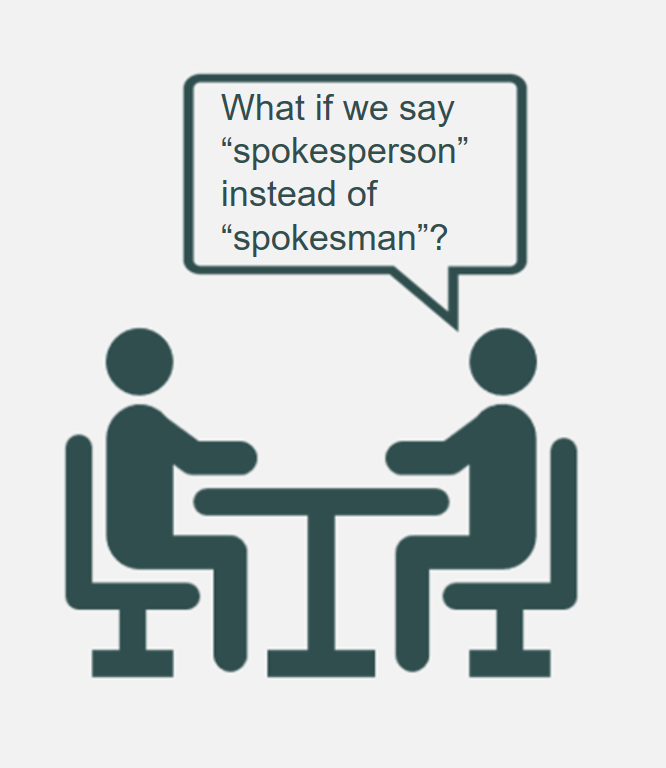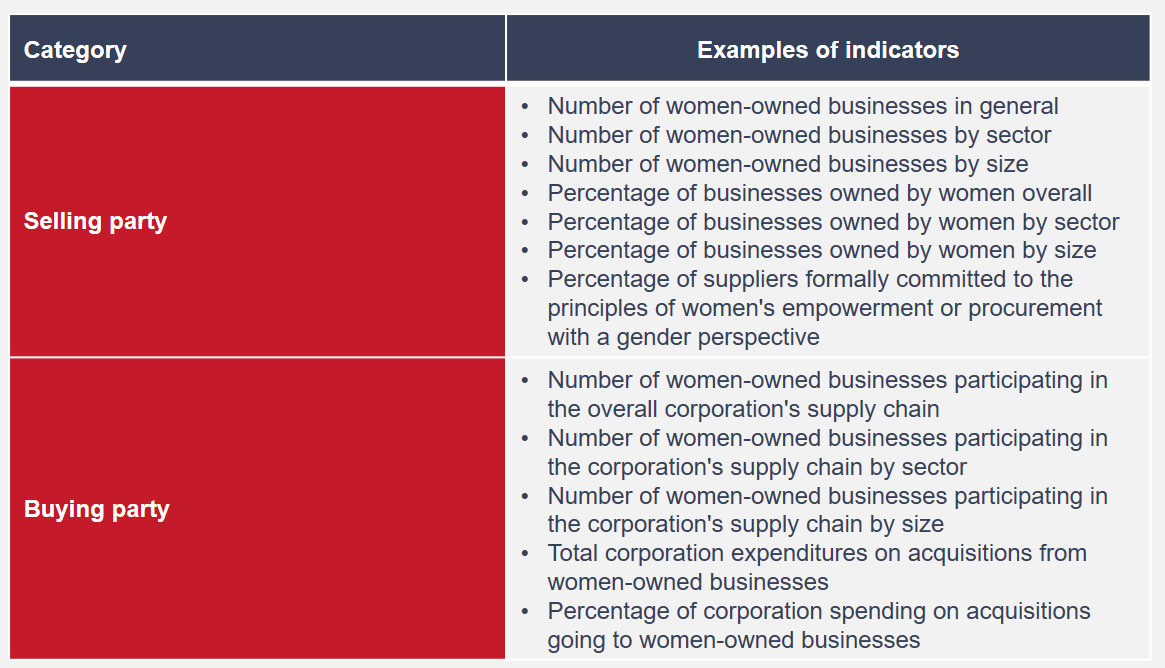Lens 4
Tool 1.
Guide to creating an inclusive value chain
Adding a gender lens to a company’s strategy encompasses all aspects of planning, implementing and monitoring policies and processes to promote equal opportunities and treatment of all staff.
This analysis can be done based on two questions:
How are the lives of the women and men who make up the company affected?
And how are the lives of the women and men who make up the value chain organizations affected?
Scroll To Learn More
Tool 1.
Guide to creating an inclusive value chain
This guide seeks to provide a simple guideline to mainstream the gender approach in the company’s value chain. List the points to consider and invite reflection.
This is a typical value chain:

To include the gender approach, we must ask ourselves: what impact do the company’s actions have on the lives of women and men who make up the organizations in the value chain of my company?

How are the lives of the women and men who make up the company affected?
Challenges.
Regarding the first question, there are still multiple challenges to achieve equal participation in the workplace:
-
- There is a lower proportion of women than men in managerial positions.
- Unconscious stereotypes and biases persist about positions and responsibilities that women and men should have.
- There is difficulty in having joint responsibility between work life and personal life.
- Care permits are rarely used by men.
- The organizational culture sometimes allows workplace violence, harassment, and sexual harassment.
Actions.
Some measures that organizations can implement to face these challenges and promote gender equality are:
1. Human capital management with equal opportunities and treatment

Visit the lens 2, equality in the workplace to learn about strategies related to this topic
2. Use of sex-disaggregated information
- Understand the differentiated situation of women and men.
- Make informed decisions: plan, prioritize, monitor.
- Exploit the available data including the sex variable.
- Specify population, indicators and targets disaggregated by sex in a systematic way.

Visit the section on data analytics of lens 3. Products and services that benefit women and girls to learn about tools related to this topic
3. Inclusive communication in language and images
- Using non-sexist and inclusive language and images makes women’s participation in the organization and the market visible.
- Explore the options: abstracts, articles, occupations in feminine.
- Put the word “person” before when talking about groups in situations of discrimination.
- Show the diversity of women and men without stereotypes.
The tools on inclusive communication are in this same lens, get to know them!

How are the lives of women and men who make up the value chain organizations affected?
Challenge:
Regarding the second aspect, companies led by women receive less than 1% of the amount that large companies invest in supplies and services, and they face greater challenges to join the value chains of companies due to factors such as the following:
-
- They are fewer, in a greater proportion of micro size and in the informal sector.
- They have less access to financing and capital.
- They face difficulties to establish solid commercial networks, they resort to informal contacts.
- Stereotypes and unconscious biases prevail about sectors and responsibilities in which women and men should work.
- They experience conflicts to make time spent in business compatible with personal life.
Actions.
Some measures that organizations can implement to promote gender equality in their value chain, helping to eliminate the obstacles exposed, are:
-
- Carry out a gender diagnosis on supplier and distribution companies.
- Take advantage of the influence of the company to promote gender equality.
- Communicate the equality and inclusion agenda to staff, business partners and other interested parties, establishing a dialogue that guarantees support for the company’s actions.
- Standardize the procedures to become a supplier or distributor company.
- Gather information on relevant criteria: company ownership, equality policies, proportion of women and men.
- Collaborate with associations of businesswomen, organizations that promote purchases with a gender perspective and companies that share the values of equality and inclusion.
- Establish special measures for companies that meet equality and inclusion criteria (led by women, with equality policies, with a high proportion of women): goals, indicators, quotas, higher scores, prequalification, detection of needs, events to establish contact .
- Support the development of women-led businesses to meet the criteria for participation.
- Give feedback to companies that do not win a bid.
Women Owned Businesses
The proposed definition contains several criteria that a business must meet in order to be considered women-owned:
-
- One or more women must unconditionally own at least 51% of the business.
- One or more women should exercise control over long-term decision-making and the day-to-day management and administration of business operations.
- The business must operate without relying on other businesses that are not owned by women.
Gender diagnosis on supplier and distribution companies
Questions to ask
Among the actions mentioned is the elaboration of a gender diagnosis on supplier and distribution companies, for which it is necessary for the organization to ask itself the following questions about its value chain:
-
- Were any gender equality criteria used for the selection?
- Who owns the business and who makes the decisions?
- What is the value of the contracts of women’s companies?
- What proportion of women and men are there at the managerial and operational level?
- Do women and men have the same access to productive resources?
- What activities do women and men do? Are there stereotypes or expectations about appropriate sectors and tasks for each other?
- Do they allow co-responsibility work life-personal life?
- Do they have equality policies between women and men?
- Is there interest in working for gender equality?
- Is there information on the ownership of the companies that are out of the tenders?
Indicators
In order to measure the impact of the actions, it is necessary to follow up with specific indicators. Indicators can measure quantity (quantitative) or quality (qualitative). Here are some examples taken from the UN Women guide “The Power of Procurement: How to Buy Products and Services from Women-Owned Businesses”

Actions for equal opportunities in the value chain: good practices in companies
Take advantage of the influence of the company to promote gender equality
The 5 & 5 by ’25 initiative of the SAP company encourages companies around the world to have the same goal: 5% of the supply amount comes from social companies and 5% from companies with diversity.
Collaborate with business associations and organizations that promote purchases with a gender perspective
WeConnect International is an organization that identifies, supports and certifies women's companies to generate business opportunities with multinational corporations.
Establish special measures for companies that meet equality and inclusion criteria
indicators, goals, scores, tiebreaker criteria, detection of needs, training. At UN Women, in the event of a tie, preference is given to women-owned businesses and offers online training to women's businesses and purchasing professionals. The Whirlpool company and its Consulado da Mulher program support women in poverty, moving forward to become providers of the organization's cafeterias and catering for their events.
To find out more cases of companies that are carrying out these actions, go to:
Santander
AB InBev
Verification List
It is useful to prepare a checklist that makes it easier to identify the actions that already exist or are being carried out in the company, which are pending and could be carried out, as well as having the set of measures that organizations can implement to promote gender equality in its value chain.
Deetken Impact
Suite 500 – 210 West Broadway
Vancouver, BC V5Y 3W2
+1 (604) 731-4424 ext. 110
impact@deetken.com
Pro Mujer
1129 Northern Blvd #404
Manhasset, NY 11030
+1 (646) 626-7000
communications@promujer.org
This toolbox is made possible by the support of the American People through the United States Agency for International Development (USAID) under the terms of Contract No. AID OAA-C-17-00090. The contents of this toolkit are the sole responsibility of Deetken Impact and Pro Mujer and do not necessarily reflect the views of USAID or the United States Government.


